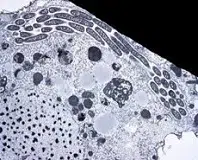In order to discover the meaning of the term intracellular, it is necessary, first of all, to know its etymological origin. In this case, we have to emphasize that it is a word that derives from Latin and that has been formed from the sum of several Latin lexical components such as the following:
-The prefix “intra-”, which means “inside”.
-The noun “cellula”, which can be translated as “cell” or “little cell”.
-The suffix “-ar”, which is used to indicate “belonging” or “relationship”.
The adjective intracellular is used to refer to what is found or develops inside a cell : the fundamental constituent of a living being, which has the ability to reproduce independently.
 The intracellular fluid , in this framework, is a fluid found inside the cells . The cell membrane is responsible for separating it from the extracellular fluid and managing the passage of substances that are dissolved in both.
The intracellular fluid , in this framework, is a fluid found inside the cells . The cell membrane is responsible for separating it from the extracellular fluid and managing the passage of substances that are dissolved in both.
In cells, therefore, there are intracellular compartments , where intracellular fluid is stored. The low concentration of sodium and the high concentration of potassium are two of the characteristics of this fluid.
It should be noted that the intracellular fluid is the main component of the cytosol , also called the cytoplasmic matrix . In the case of eukaryotic cells, for example, the cytosol is part of the cytoplasm .
In the cytosol and cell nucleus, on the other hand, intracellular receptors are located. These elements make it possible to identify chemical messengers, such as hormones and neurotransmitters.
Likewise, we cannot forget that when talking about intracellular bacteria we must take into consideration that there are two very well differentiated models:
-Facultative bacteria, which have the peculiarity that they have the ability to live both in the extracellular and intracellular environment. In this group we find bacteria such as legionella, listeria or salmonella.
-The obligate bacteria. Under this name are those that need the internal cellular environment not only to survive but also to multiply. What's more, they are not capable of surviving outside cells. Examples of this type of bacteria are those called chlamidiae and those also known as rickettsia.
Intracellular digestion , meanwhile, is a heterotrophic nutrition process that amoebas and other unicellular organisms carry out inside the cell. Thanks to their enzymatic system, these beings can degrade the molecules in the vacuoles . The hydrolytic enzymes that allow the process to be carried out are generated mainly by lysosomes.
It is also important to know that this type of digestion must be clearly differentiated from what is called extracellular digestion. What distinguishes one from the other is that, while the intracellular system requires a digestive system, it is not necessary in the extracellular system.
Intracellular traffic, intracellular transport y intracellular messenger son otras nociones que pueden construirse a partir de la utilización del adjetivo intracelular.
